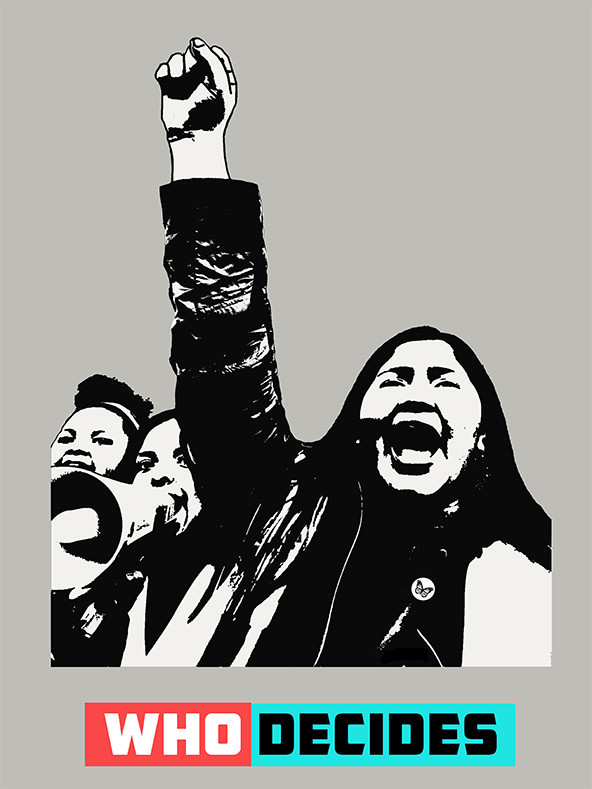 (Art by Nicolas Lampert)
(Art by Nicolas Lampert)
When Margaret Thatcher infamously said, “And, you know, there’s no such thing as society. There are individual men and women and there are families,” she wasn’t making an observation. She was declaring a strategy to unmake a once-powerful working class. For several decades, at least since Thatcher and Ronald Reagan delivered severe blows to unions in their respective countries, it has been open season on workers. Academics and policymakers argue about how to preserve or restore a decent quality of life for workers—all for naught.
Realizing Democracy

These articles, funded by the Ford Foundation as part of the Realizing Democracy project, speak to an increasingly shared understanding among policymakers, civil society leaders, and scholars that democracy reform today must address underlying systemic roots of exclusion and inequality. The ideas reflect the views of the authors solely.
These endless debates about how to reverse income inequality and restore and strengthen democracy are a constant distraction from a more urgent need: workers who can organize together to form fighting organizations capable of effective mass collective action. Two of the most democratizing movements in US history—the union movement of the 1930s and 1940s, and the civil rights movement of the 1950s and 1960s—both relied heavily on confronting a seemingly unshakable power structure with direct-action organizing. Both movements understood that challenging power required power-building strategies. The only strategic advantage that the non-elite have over billionaires and the political elite is population size. To win elections or policy or political support, those large numbers must create sustainable, demonstrable supermajorities capable of persuading corporations and the political elite to come to the negotiating table.
The best evidence that unions continue to be not only relevant but urgent is the explosion of labor strikes over the past 18 months. These include the multicity, multistate strike by low-wage immigrant workers against Marriott, the largest hotel corporation in the world; the uprising by 31,000 Stop & Shop workers in New England; and the enormous strikes in the education sector, like the one in Los Angeles. The victories have been uneven, but each strike either has stopped egregious corporate behavior or has led to progressive breakthroughs not seen in decades.
When it comes to the Los Angeles teachers’ strike, the policy wins are more enforceable than legislation because workers have secured the right to redress if employers try to evade implementation. More important, the teachers, students, and parents together built organizations capable of implementing their achievements. According to Alex Caputo-Pearl, an award-winning high school teacher of 22 years and president of United Teachers Los Angeles (UTLA), “We knew they’d never agree to our demands, including Green Spaces, creating an Immigrants Defense Fund [US Immigration and Customs Enforcement had been increasingly targeting schools], a big expansion of school nurses and guidance counselors, or our top demand to reduce the number of kids per class, unless and until we were out on strike with parents standing united behind the demands.”
Caputo-Pearl knew this because the students, the parents, and their teachers were pitted against a recently appointed school board superintendent who was a hedge fund billionaire with zero experience in the education field. Less than 60 days after his appointment in May 2018, Austin Beutner published a report titled “Hard Choices,” which declared that teachers were overpaid and overcompensated, and called for a 47 percent reduction in their benefits, which he declared to be “too generous.” This is in Los Angeles, where full-time workers live in their cars and buy gym memberships to shower. With per pupil spending in California ranked 47th in the nation, Beutner declared that teachers—who buy pencils, paper, and tampons for their students—were overpaid, setting the stage for what became the first strike in 30 years. The school board management had been steadily converting public schools in Los Angeles into private corporate charter schools, the largest and most steady expansion in the nation. Beutner’s report was a declaration of his intent to defeat the teachers’ union in a head-on confrontation. After all, teachers’ unions were flat on their backs, right?
For the six months following the release of his report, under his direction the school board repeatedly attempted to get legal injunctions and used lawsuits and other tactical gimmicks to try to weaken and demoralize the teachers. What blocked him was a four-year effort of the best teachers who rebuilt their once-do-nothing union into a powerhouse organizing machine.
Each policy achievement was won contractually through the collective bargaining process. In Los Angeles, many of the demands presented by the teachers’ union were proposals that parent groups and the broader community had been trying to win for years, without success. Examples include forcing annual reductions in class size by capping student-teacher ratios; securing more wraparound services for low-income youth and youth of color by hiring more school nurses, librarians, and counselors; and making vast improvements in wages and health-care benefits for the mostly women of color workforce. The policy wins have also included specific measures that challenge direct and indirect racism, including banning so-called random searches, almost all of which target youth of color and ultimately direct them to the prison, not college, pipeline.
Ending random searches was a central issue in the negotiations. The teachers won an experimental ban on these racist practices in 30 schools, and the victory emboldened the racial justice community and raised its expectations for a total ban across all 900 Los Angeles schools. To secure the district-wide policy, the teachers led a movement that translated their all-out worker strike into an all-out picket-lines-to-the-polls election for a vacancy on the school board—a campaign that had to begin on the heels of the strike. Despite exhaustion, by May, they had elected a progressive school board candidate, setting the stage for the June 2019 banning of searches that research shows were anything but random.
Another example of a remarkable achievement from the 100 percent out strike was the win for Green Spaces. Hedgefund bankers representing the corporate wing of the Democratic Party dug in their heels against the 34,00 teachers demanding improvements to the physical, emotional, and mental health of more than half a million students of color. Despite their resistance, the new contract calls for the school board to immediately form a Green Space Task Force that includes representatives from the LA Unified School District (LAUSD), UTLA (the union), and the City of Los Angeles. LAUSD will work with UTLA, the City of Los Angeles, the County of Los Angeles, and appropriate nonprofit partners to create—to the maximum extent possible—adequate green space for student physical activity.
According to the task force plan, green space will be constructed in order of priority: schools without any existing green space and not located near parks; followed by schools without any existing green space; and, finally, schools with small amounts of green space and communities with limited to no access to parks and recreation.
That was big, but the Green Spaces provision also calls for removing the metal bungalows used as classrooms on K-12 campuses across the district. The structures, which resemble shipping containers, are a manifestation of the disinvestment in America’s public schools and the disinvestment in the American public. At one point, the city considered buying some used bungalows from the school district to use as shelters for the rapidly expanding homeless population, but it ultimately decided against the idea because the containers were in such poor condition. Yet they were deemed good enough for low-income kids to spend most waking hours in, allegedly learning the skills that would prepare them for life. The idea of equality of opportunity would be a joke if not for teachers fighting through their union, with their heart and feet, to make it so.
Los Angeles’s progressive educators led a master class in how to rebuild strong, socially relevant unions, and how to expand their base by building solidarity with students, parents, and the broader community. It happened fast, and the results are a model for exactly what needs to happen nationwide. These victories required power, not merely “a voice.”
Good strikes force the very consensus building that America needs, and the sooner we reprioritize unions, the sooner we can reclaim democracy.
This article appeared in the Winter 2020 issue of the magazine with the headline: “Reversing Income Inequality”
Support SSIR’s coverage of cross-sector solutions to global challenges.
Help us further the reach of innovative ideas. Donate today.
Read more stories by Jane McAlevey.

